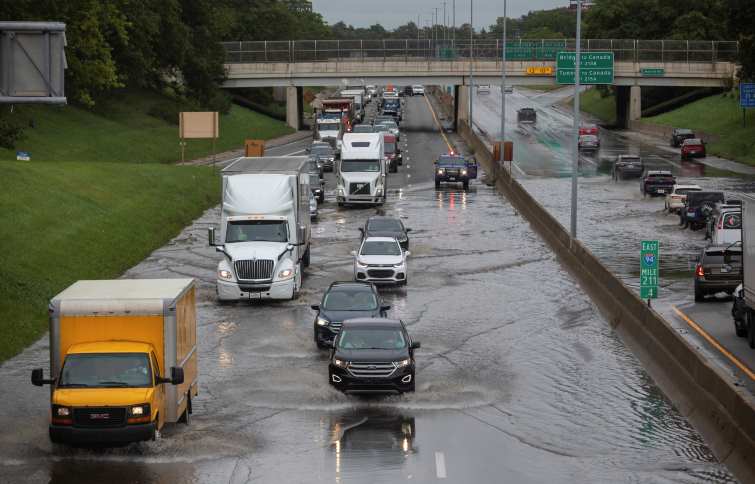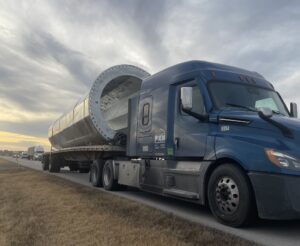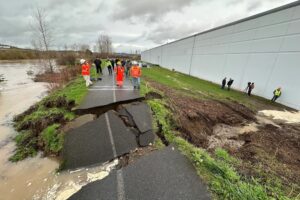CANTON TOWNSHIP, Mich. — At least one tornado touched down in Michigan as part of severe storms powered by winds of up to 75 mph that downed trees, tore roofs off buildings and killed five people while leaving hundreds of thousands of customers without power, officials said.
The National Weather Service on Friday confirmed that an EF-1 tornado with winds of 90 mph crossed from Ingham County into the western edge of adjacent Livingston County on Thursday night.
Preliminary information shows that after entering Livingston County, the tornado remained on the ground for a mile or less before “weakening and lifting,” said Dave Gurney, a meteorologist with the weather service’s office in Oakland County’s White Lake Township.
In western Michigan, the Kent County Sheriff’s Office said a 21-year-old woman and two girls, ages 1 and 3, died Thursday night after two vehicles collided head-on as it was raining.
“There was two vehicles traveling toward each other. One hydroplaned on water and it was occupied by four people,” Sgt. Eric Brunner told WZZM-TV.
The sheriff’s office said a 22-year-old Gowen man who was driving the car carrying the Gowen woman and two girls was seriously injured in the crash, which occurred when his car struck an SUV. That vehicle’s driver suffered minor injuries.
In Lansing, the state capital, one person died Thursday night after a tree fell on a home. Lansing Police Department spokeswoman Jordan Gulkis told the Lansing State Journal that firefighters extricated one person from the home but that person was pronounced dead at a hospital.
In Ingham County, where Lansing is located, the sheriff’s office said Friday that one person was confirmed dead and several people severely injured as more than 25 vehicles were severely damaged along Interstate 96.
Trees were uprooted, and some roofs collapsed during Thursday’s storms, leaving many roads closed due to fallen trees and power lines.
The weather service office in Grand Rapids, in western Michigan, said officials would be in the field Friday conducting damage surveys on a suspected tornado in Kent County.
In the north Detroit suburb of Southfield, Muqitu Berry said he was in his ranch home about 9:30 p.m. Thursday when a large part of the trunk of a neighbor’s tree came crashing down, sounding “like a train coming through.”
The tree ended up across the front of Berry’s driveway and yard and took down power lines, dropping them onto his driveway and at least one vehicle, leaving Berry and his neighbors without power.
“I can’t get out of my driveway. I can’t go anywhere,” Berry said Friday morning. “We’re out of power, and it’s very frustrating.”
Wayne County Executive Warren Evans declared a state of emergency Friday in Michigan’s largest county, which includes Detroit, due to power outages, flooding, fallen trees and power lines and storm debris.
The county also warned residents to avoid any contact with several rivers after flooding caused municipalities to discharge partially or fully untreated wastewater into various waterways.
In Macomb County, northeast of Detroit, several thousand basements in Eastpointe and St. Clair Shores were spared flooding when stormwater and wastewater were discharged to Lake St. Clair through an emergency bypass system, Public Works Commissioner Candice Miller said. The bypass has been used only three times since 2017 but twice this week.
“Apparently, these storms have become our new normal,” Miller said. “This has been like a tropical storm, and both government and residents will need to make appropriate preparations whenever possible.”
Canton Township, a community of some 100,000 west of Detroit, was hit earlier this week by flooding in its downtown business district. Then Thursday night’s storms produced what are believed to be “two at least heavy wind shears, if not tornadoes,” said township supervisor Anne Marie Graham-Hudak.
“Some of our parks are destroyed,” she said, adding that the township received calls from 200 residents regarding flooding in their basements.
More than 460,000 customers in Michigan and over 218,000 in Ohio were without power as of about 11:30 a.m. Friday, according to the Poweroutage.us website.
Thursday night’s storms followed a round of heavy rain Wednesday that left areas in southeast Michigan with over 5 inches (12.7 centimeters) of rain by Thursday morning, resulting in street flooding in the Detroit area, including tunnels leading to Detroit Metropolitan Airport in the suburb of Romulus, officials said. Officials reopened the airport’s McNamara Terminal on Thursday afternoon. Severe storms developed in the western part of the state in the afternoon.
Michigan Gov. Gretchen Whitmer activated the State Emergency Operations Center on Thursday evening to provide support to affected communities “as they respond to the impacts of flooding.”
Parts of the western United States have been deluged in recent weeks with rain from Tropical Storm Hilary, and much of the central U.S. was beaten down by deadly sweltering heat. In Hawaii and Washington, emergency crews battled catastrophic wildfires.
Scientists say that without extensive study they cannot directly link a single weather event to climate change, but that climate change is responsible for more intense and more frequent extreme events such as storms, droughts, floods and wildfires. Climate change is largely caused by human activities that emit carbon dioxide, methane and other greenhouse gases into the atmosphere, according to the vast majority of peer-reviewed studies, science organizations and climate scientists.
The Associated Press is an independent global news organization dedicated to factual reporting. Founded in 1846, AP today remains the most trusted source of fast, accurate, unbiased news in all formats and the essential provider of the technology and services vital to the news business. The Trucker Media Group is subscriber of The Associated Press has been granted the license to use this content on TheTrucker.com and The Trucker newspaper in accordance with its Content License Agreement with The Associated Press.














